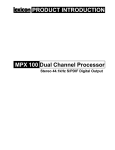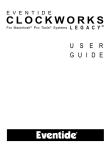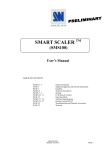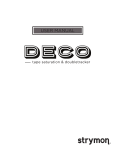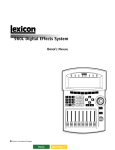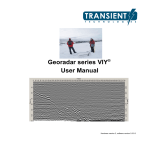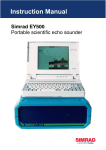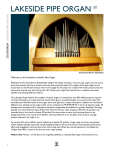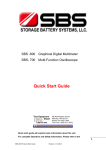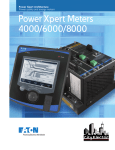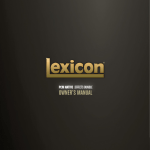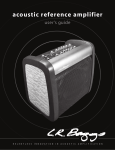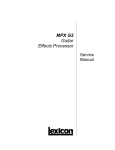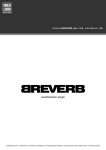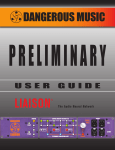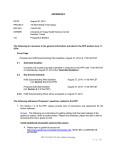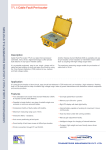Download effects processors
Transcript
effects processors 2 3 Lexicon® occupies a unique position as a leading innovator in both the professional and consumer audio industries. Since the release of our first digital audio product in 1971, Lexicon has stood at the forefront of digital audio with an enviable reputation as a manufacturer of exceptional professional audio and home theater products and an inventor of exciting new technologies.Years of research, development, and experience allow us to continue expanding the boundaries of the listening experience. Our professional audio products are prominent in the creation of worldwide music, television, and film productions. These products have won numerous awards, including an impressive collection of TEC Awards and an Emmy. Lexicon processors have been embraced as the standard in professional signal processing since the introduction of the 480L Digital Effects Processor, which has retained tremendous popularity for the past 17 years. It has since been replaced as the standard in professional signal processing by the 960L Multi-channel Digital Effects System, which has itself garnered an impressive following of producers, artists, and engineers. Built to professional standards, our award-winning music and cinema products are present in fine home theaters all over the world.With the release of our first digital processor in 1988, Lexicon earned a reputation as a premiere manufacturer of home theater products. Since then, our products have continued to set new benchmarks for performance. Combining power, precision, and flexibility with an elegant industrial design, the two newest additions to this proud lineage of products are no exception.The MC Series Digital Controllers and the LX Series Power Amplifiers represent the finest expression of music and film reproduction available. Growing demand for proprietary Lexicon technologies has led to their appearance in numerous applications – with dramatic results. Our processing is relied upon to enhance the sound of prestigious live halls and venues. Our critically acclaimed LOGIC7® technologies have been successfully incorporated in several world-renowned automobiles, including select models from BMW and Mercedes. LOGIC7 technologies have also been licensed to other audio companies such as harman/kardon and AKG. Knowingly or unknowingly – you experience Lexicon products and technologies on a daily basis. Chances are that Lexicon processing was involved in the television program you watch at home, the film you see at the cinema, or the song you listen to on the radio. From the initial tracks to your listening room or automobile, Lexicon is part of the process that brings these recordings to life. Our commitment to the audio professional and the home theater enthusiast ensures an unbroken chain between the artist and the audience. Lexicon and LOGIC7 are the registered trademarks of Harman International Industries, Inc. All other trademarks are the property of their respective manufacturers. 4 • Legendary Lexicon reverb from proprietary LexiChip™ • 24-bit internal processing and A/D/A conversion • 240 presets and 16 User programs • 44.1kHz S/PDIF output (may be set to wet or dry for use as a highquality, stand-alone converter) • Simultaneous analog and digital outputs • Independent processing of each input • Dual programs that combine two independent effects in four routing configurations • Multiple delay, modulation, and pitch effects • Tap Tempo • Full MIDI control with software-selectable MIDI Out/Thru connector • Two-stage headroom indicators • Global Mix and Tempo Modes • High impedance inputs for instruments • Headphones output • Push-button or footswitch selection of dry or muted audio output The first tier in the award-winning MPX Series, the MPX 110 represents Lexicon’s most affordable dual-channel processor.A true stereo processor, the MPX 110 includes 24-bit analog-to-digital and digital-to-analog conversion, and relies on the proprietary LexiChip engine to perform 24-bit internal processing. Its 240 carefully-crafted presets feature legendary Lexicon reverb, as well as dual programs that combine two independent effects in four routing configurations.Tempo can be set using audio input, a dual footswitch, the front panel Tap button, or an external MIDI device. A powerful editing tool called Learn Mode allows patching of five front panel controls, while permanent MIDI patches provide access to audio parameters not available from the front panel. • • • • Easy Operation The front panel Program, Variation, Adjust, and Effects Lvl/Bal knobs provide convenient control over all 240 presets and 16 User programs.The Program knob selects among Single, Dual, and User programs, which are listed around the knob for faster selection.The Variation knob selects one of 16 variations for the selected program.The Adjust and Effects Lvl/Bal knobs demystify the process of editing programs.The Adjust knob is patched to the most critical parameters for each preset.All it takes is a simple turn of the knob to dial in the desired sound. For some presets, the Adjust knob is patched to multiple parameters to provide simultaneous control of related effects. In addition, the Effects Lvl/Bal knob controls the level of effects in Single programs or the balance of effects in Dual programs. • • • • Legendary Effects Plate, Gate, Hall, Chamber, and Room - Legendary Lexicon programs that recreate the acoustics of reverberant spaces. Ambience - World-class programs available for room sounds without reverberation. Tremolo - Programs that offer classic shapes such as square, sawtooth, triangle, sine, and rectified sine. The Adjust knob changes the synchronization of the left and right sweeps to produce mono 5 or stereo effects, and the Tap button matches the tremolo rate of the program with the tempo of the music. Rotary - Programs that simulate a Leslie®-style cabinet. Like the physical model, the high (horn) and low (drum) frequencies are separated and “spun” in opposite directions. Horn and drum speeds are independent, designed with the acceleration and deceleration characteristics that simulate the inertia of the original mechanical elements. combine Delay and Reverb algorithms, or either algorithm with a Flange, Pitch, or Chorus algorithm. Dual programs are available in four routing configurations: Dual Stereo (Parallel), Cascade, Mono Split, and Dual Mono. • • • • Tap Tempo Flange - Programs that feature two 2-tap delays, one per channel. Mixing the two tap delays together creates characteristic flange effects such as swishing, tunneling, and fading. Tap Tempo simplifies the process of matching the delay times and modulation rates of tempo-based presets with those of the music. Whenever a tempo-based preset is loaded, the Tap button LED flashes. To set tempo from the front panel, press the Tap button twice in time with the music. It is not required to enter what “could be” the delay time in milliseconds.To change tempo, just press the Tap button twice again in the new rhythm. Tempo can also be set using audio input (a must for live performances), a dual footswitch, or an external MIDI device that uses Continuous Controller or Program Change messages. Pitch - Programs that shift monophonic sources within a range of one octave up to two octaves down. • • • • MIDI Control Chorus - Programs inherited from the award-winning PCM Series that pan six independently-randomized delay voices across the stereo field to create a rich, airy effect that multiplies a single source into several. Detune - Programs with one pair of voices per channel, one sharp and one flat.These voices add a delayed or pitch-shifted version of the source to thicken the sound, creating a particularly effective simulation of doubletracking. Delay and Echo - Programs that include mono (5.5 seconds), stereo (2.7 seconds), and 6-voice multi-tap effects – each of which can be used to create tape echo or digital delay effects. Dual Programs - Programs that combine two independent effects in four routing configurations. Dual-channel processing allows the MPX 110 to The MPX 110 offers full MIDI control, thanks in part to a powerful editing tool called Learn Mode that allows patching of five front panel controls. Standard Continuous Controllers, SYSEX commands, or Program Change messages can be used to manipulate the Adjust, Effects Lvl/Bal, and Mix knobs, as well as the Bypass and Tap buttons. In addition, Program Change messages can be used to load programs. The MPX 110 also recognizes permanent, non-learnable MIDI patches that provide access to audio parameters that are not available from the front panel. In the studio, controls can be automated and recorded into a sequencing device for complete preset automation. 6 • Legendary Lexicon reverb from proprietary LexiChip • 24-bit internal processing and A/D/A conversion • 240 presets and 64 User programs • S/PDIF I/O (may be set to wet or dry for use as a high-quality, stand-alone converter) • Simultaneous analog and digital outputs • Independent processing of each input • Dual programs that combine two independent effects plus compression in four configurations • Multiple delay, modulation, and pitch effects • Built-in digital compressor with four adjustable parameters available in all programs • Tap Tempo • Full MIDI control with software-selectable MIDI Out/Thru connector • Intuitive front panel LEDs, including headroom and gain reduction indicators • Cue Program Mode • Global Mix,Tempo, and Compressor Modes • High impedance inputs for instruments • Headphones output • Push-button or footswitch selection of dry or muted audio output • Internal power supply The second tier in Lexicon’s award-winning MPX Series, the MPX 200 combines the best of the MPX 110 with additional features that provide an advanced level of operation.These new features include a built-in digital compressor, intuitive front panel LEDs, an expanded User bank that houses 64 programs, and an internal power supply. • • • • Easy Operation The front panel Adjust knob provides convenient control over all 240 presets, while intuitive front panel LEDs provide at-a-glance viewing of program and system status.The Adjust knob can be used to activate Cue Program Mode, which allows one program to run while another program is prepared for loading.The Effects LEDs indicate the effects that are included in the loaded program and, for Dual programs, the Routing LEDs indicate the routing configuration that is selected. The Adjust knob also demystifies the process of editing programs. When a parameter is selected with the Edit button, all it takes is a simple turn of the Adjust knob to dial in the desired sound.The front panel Edit LEDs indicate which parameter is selected. The Adjust knob is patched to the most critical parameters for each preset. • • • • Legendary Effects Plate, Gate, Hall, Chamber, and Room - Legendary Lexicon programs that recreate the acoustics of reverberant spaces. Ambience - World-class programs available for room sounds without reverberation. Tremolo - Programs that offer classic shapes such as square, sawtooth, triangle, sine, and rectified sine. The Adjust knob changes the synchronization of the left and right sweeps to produce mono or stereo effects, and the Tap button matches the tremolo rate of the program with the tempo of the music. 7 Rotary - Programs that simulate a Leslie-style cabinet. Like the physical model, the high (horn) and low (drum) frequencies are separated and “spun” in opposite directions. Horn and drum speeds are independent, designed with the acceleration and deceleration characteristics that simulate the inertia of the original mechanical elements. Chorus - Programs inherited from the award-winning PCM Series that pan six independently-randomized delay voices across the stereo field to create a rich, airy effect that multiplies a single source into several. Flange - Programs that feature two 2-tap delays, one per channel. Mixing the two tap delays together creates characteristic flange effects such as swishing, tunneling, and fading. Pitch - Programs that shift monophonic sources within a range of one octave up to two octaves down. Detune - Programs with one pair of voices per channel, one sharp and one flat.These voices add a delayed or pitch-shifted version of the source to thicken the sound, creating a particularly effective simulation of doubletracking. Delay and Echo - Programs that include mono (5.5 seconds), stereo (2.7 seconds), and 6-voice multi-tap effects – each of which can be used to create tape echo or digital delay effects. Dual Programs - Programs that combine two independent effects in four routing configurations. Dual-channel processing allows the MPX 200 to combine Delay and Reverb algorithms, or either algorithm with a Flange, Pitch, or Chorus algorithm. Dual programs are available in four routing configurations: Dual Stereo (Parallel), Cascade, Mono Split, and Dual Mono. • • • • Compression The MPX 200 features a built-in digital compressor that works in front of and in addition to its outstanding effects. The compressor can be used to prevent volume from exceeding a certain level, or to subtly reduce volume changes to make quieter passages in program material seem louder. Its function depends on the setting of its four parameters – Attack, Ratio, Release, and Threshold, all of which are included on the front panel Edit display for simple adjustment. All it takes is a press of the front panel Compressor button to power compression on and off in any program. • • • • Tap Tempo Tap Tempo simplifies the process of matching the delay times and modulation rates of tempo-based presets with those of the music. Whenever a tempo-based preset is loaded, the Tap button LED flashes. To set tempo from the front panel, press the Tap button twice in time with the music. To change tempo, just press the Tap button twice again in the new rhythm. Tempo can also be set using audio input (a must for live performances), a dual footswitch, or an external MIDI device that uses Continuous Controller or Program Change messages. • • • • MIDI Control Full MIDI control is offered via a powerful editing tool called Learn Mode that allows patching of five front panel controls. Continuous Controllers, SYSEX commands, or Program Change messages can be used to manipulate the Adjust, Effects Lvl/Bal, and Mix knobs, as well as the Bypass and Tap buttons. Program Change messages can be used to load programs. 8 • Legendary Lexicon reverb from proprietary LexiChip • 24-bit internal processing and A/D/A conversion • Selectable 44.1 or 48kHz sampling rate • 255 presets and 64 User programs • Dynamics algorithm with enhanced metering • S/PDIF I/O (may be set to wet or dry) • Balanced analog I/O (XLR and 1/4 inch TRS) • Simultaneous analog and digital outputs • Independent processing of each input • Dual programs that combine two independent effects in four routing configurations plus compression • Multiple delay, modulation, and pitch effects • Built-in digital compressor with four adjustable parameters • Tap Tempo • Full MIDI control with software-selectable MIDI Out/Thru connector • Large, graphic front panel display • Four Edit knobs for quick parameter adjustment • Cue Program Mode • Global Mix,Tempo, and Compressor Modes • High impedance inputs for instruments • Headphones output • Internal power supply The third tier in Lexicon’s award-winning MPX Series, the MPX 550 offers high-end professional features and “Lexicon Sound” at an affordable price. Like its predecessors, the MPX 550 is a true stereo processor that includes 24-bit analog-to-digital and digital-to-analog conversion. It relies on the proprietary LexiChip engine to perform 24-bit internal processing. Its 255 carefully-crafted presets feature legendary Lexicon reverb, as well as dual programs that combine two independent effects in four routing configurations. Tempo can be set using audio input, a dual footswitch, the front panel Tap button, or an external MIDI device. A powerful editing tool called Learn Mode allows MIDI patching of up to five front panel controls. To this, the MPX 550 adds impressive features such as balanced analog inputs and outputs, a large front panel display, four Edit knobs for simple parameter adjustment, and an internal power supply. • • • • Easy Operation The front panel Program and Edit knobs provide convenient control over all 255 presets and 64 User programs, while a large, graphic front panel display provides at-a-glance viewing of program and system status.When the Load button is pressed, the Program knob selects among Single, Dual, and User programs. Otherwise, the Program knob activates Cue Program Mode, which allows one program to run while another is prepared for loading.The Load button LED lights to indicate that a program is cued for loading.The front panel display indicates the name of the cued program for 4 seconds, then reverts to showing the name of the program that is currently running. Dedicated Edit knobs work with well-organized Edit Pages to demystify the process of editing programs. Each program includes up to 20 parameters that are organized into Edit Pages.The front panel Edit Pages button cycles through parameters available for the loaded program. Each Edit knob is patched to the corresponding parameter listed across the bottom of the front panel display. Each program also features an “Adjust” parameter – a special parameter selected for each preset that controls the most critical aspect of the sound. For some presets, the “Adjust” parameter actually controls several parameters at once to allow simultaneous control over related effects. 9 • • • • Legendary Effects In addition to the world-class effects provided by the MPX 200: Improved Reverb Algorithms with a more spacious sound, and a smoother, more natural decay. Compressor – Provides compression and limiting with ratios from 1:1 (off) to 10:1 (limiter). The Adjust parameter can be used to volume match input and output levels. Reverb can be used in parallel with the compressor, or with the compressor acting as an input limiter before the reverb to tame runaway sibilance in the reverb itself. Dynamics – Intended for use in the studio when dynamic processing of stereo signals is required. It offers peak expansion, compression, and tape saturation effects, as well as metering options that provide precise visual indication of peak expansion, gain reduction, and input and output levels. Live-FOH (Front of House) – Designed for live performances, with controls that are more convenient for live sound engineers.All presets are Dual Mono to accommodate sound reinforcement systems used in most small to mid-size venues. The first two Edit Pages contain the four most essential parameters for the first and second effects respectively. Two different knob mappings accommodate multiple work styles. Whenever a tempo-based preset is loaded, the Tap button LED flashes.To set tempo from the front panel, press the Tap button twice in time with the music. It is not required to enter what “could be” the delay time in milliseconds.To change tempo, just press the Tap button twice again in the new rhythm. Tempo can also be set using audio input (a must for live performances), a dual footswitch, or an external MIDI device that uses Continuous Controller or Program Change messages. • • • • MIDI Control The MPX 550 offers full MIDI control, via a powerful editing tool called Learn Mode that allows patching of five front panel controls. Standard Continuous Controller, SYSEX commands, or Program Change messages can be used to manipulate the Adjust, Effects Lvl/Bal, and Mix knobs, as well as the Bypass and Tap buttons. In addition, Program Change messages can be used to load programs. In the studio, controls can be automated and recorded into a sequencing device for complete preset automation. New edit icons simplify parameter adjustment. • • • • Tap Tempo Tap Tempo simplifies the process of matching the delay times and modulation rates of tempo-based presets with those of the music. Dynamics level meters show I/O levels, gain reduction, peak expansion. 10 • World-class Lexicon reverb: Plate, Gate, Hall, Chamber, and Ambience • 2 DSP engines including Lexicon’s proprietary LexiChip • 24-bit A/D and 24-bit D/A conversion • 200 presets; 50 User programs • Up to six simultaneous effects • Multiple delay, modulation, and pitch effects • Effects include Reverb, Delay, Flange, Pitch, Chorus, Rotary, Parametric EQ, Sweep Filter, and Tremolo • Large graphic display • S/PDIF input and output • Balanced analog inputs and outputs (XLR and 1/4 inch TRS) • Independent processing on each input • Tap Tempo for instant setting of delay and modulation times (may be set using footswitch) • Full MIDI control • Internal power supply • Optional MPX R1 remote controller With two separate DSP processors, the MPX 1 Multiple Processor FX stands in a class all its own. The proprietary LexiChip delivers legendary Lexicon reverb and ambience algorithms, and a second DSP processor delivers additional effect algorithms. The result is uncompromising stereo Reverb and Ambience effects that are available at all times, whether running alone or with Pitch, Chorus, EQ, Modulation, or Delay effects. Many “multi-effect” processors do not meet this basic requirement. But the MPX 1 exceeds this expectation with enough processing power left over to run even more effects. • • • • Easy Operation Front panel displays and indicators provide instant feedback about active and available features. The Tempo LED flashes to indicate the current tempo in programs that use tempo-controlled delay times and modulation rates. The Tap button allows quick tempo changes. The A/B LED lights to indicate that the A/B button is available to morph between effect or parameter variations. The numeric display makes program and patch numbers highly visible. The alphanumeric display shows parameter names and values, preset numbers, and algorithm routings. Dedicated Mix and Patch buttons provide instant access to mix and level settings for single or multiple effects and to the MPX 1 patch system.The Patch button lights whenever a patched parameter is displayed. Six effect blocks are always accessible via dedicated, back-lit buttons on the front panel. Each block is independent, with its own bypass, mix, and level controls. Effect buttons light to indicate active effects. Selecting new effects for programs is simple, with an arsenal of effects for each block (56 total) just a button push away. Push-button access to a soft row that contains the most critical parameters for each program simplifies the process of fine-tuning presets to match music or soundtracks. Edit Mode provides an extensive pool of parameters for creating and restructuring presets. • • • • On-Board Help A built-in help feature provides guidance through all front panel controls. Whenever a button is pressed and held, a message appears explaining its function without executing its action. 11 • • • • Program Library • • • • Options Button The MPX 1 offers an extensive program library that has been crafted to provide sounds suitable for performance, production, and sound design applications. These programs exploit the unique characteristics of each effect, and furnish useful examples of effect combinations that can be created with the MPX 1. A built-in database function makes it simple to locate the desired program. This database is user-definable, allowing reorganization as needed. The MPX 1 provides as much control as possible, while keeping unused options hidden until needed. The Options button lights when additional features are available. For example, delay parameters can be displayed in feet, meters, milliseconds, or echoes-per-beat. Rate parameters can be displayed in Hertz(Hz) or cycles-per-beat. Feedback options allow effect blocks to be inserted in delay or echo feedback loops. • • • • World-Class Effects Lexicon’s renowned reverb algorithms serve as the foundation for the MPX 1. Plate, Gate, Hall, Chamber, and Ambience effects are true stereo with independent processing of the left and right inputs. The MPX 1 features 56 Pitch, Chorus, EQ, Modulation, Delay, and Reverb effects, including high-precision (32-bit) Parametric EQ; rotary speaker cabinet simulator; high-quality 2-voice pitch shifter; delays and echoes (dual, mono, and stereo); Looper and Ducker; multi-voice stereo Autopanner; Chorus; Flangers; Phase;Wah; and more. Effect ordering and routing within each program is flexible. Effects can be arranged in any order by “dragging and dropping” them on a visual map. Similarly, a routing map allows distribution of the six effect blocks across two parallel stereo paths, which can be split and merged at multiple points. The routing map can be rewired by changing graphic “patch cords”. • • • • Patching System The ability to control dynamic effect parameters is essential to creating great-sounding programs. The MPX 1 patch system provides over 150 controllers that can be assigned to any parameter, including LFO (2), ADR (2), Envelope Follower (2), Arpeggiator, Random Generator, A/B Glide, Tempo, and a Sample and Hold Generator. Five patches are available per program. In addition, 10 global patches are available at all times. • • • • MIDI Control Full MIDI control is available for individual and master Mix, Bypass, and Level controls; Tap and A/B controls; and all effect parameters. Tempo parameters can be synchronized to incoming MIDI clock, or the MPX 1 can transmit its own MIDI Clock based on Tap Tempo. Internal control sources such as audio levels, LFOs, ADRs, S/H, and pedals can be sent as Continuous Controllers. A built-in arpeggiator “plays” MIDI sound generators and produces synchronized audio effects. 12 • • • • • • • • • • • • • • • World-class Lexicon reverb 2 DSP engines including Lexicon’s proprietary LexiChip 24-bit A/D, D/A, and internal processing 300 presets; 50 User programs Studio-standard reverbs and effects including: Reverb and six voices of Delay or Reverb, four voices of Pitch Shift, and Vocal Fix for replacing out-of-tune melody lines A single Adjust knob that automatically attaches to all applicable parameters in factory tailored presets PCMCIA card slot for program storage Optional cards for algorithms, programs and User presets Pro and Go Modes: Go mode allows access to as many as 10 handpicked parameters for any particular preset; Pro Mode allows full access to an Edit matrix of as many as 100 parameters Dynamic Spatialization: 3D effects processing (compatible with surround sound systems) Up to 20 seconds of delay Balanced analog inputs and outputs (XLR and 1/4") S/PDIF and AES/EBU digital inputs and outputs Tap Tempo for instant setting of delay and modulation times Full MIDI control 13 • • • • • • • • • • • • • World-class Lexicon reverb Dual proprietary LexiChip DSP engines 24-bit A/D, D/A, and internal processing 450 presets; 100 User programs Lexicon's "Greatest Hits" reverb algorithms, including Chamber, Concert Hall, Random Ambience, Random Hall, Rich Plate, and Split Chamber Keyword search for quick, intelligent sorting of presets by alphabetical order or application Front panel Adjust knob automatically attaches to one or more parameters in each factory tailored preset PCMCIA card slot for program storage Pro and Go Modes: Go mode allows access to as many as 10 handpicked parameters for any particular preset; Pro Mode allows full access to an Edit matrix of as many as 100 parameters Balanced analog inputs and outputs (XLR and 1/4") S/PDIF and AES/EBU digital inputs and outputs Tap Tempo for instant setting of delay and modulation times Full MIDI control 14 For over 30 years, Lexicon has been considered a pioneer in digital audio.With more experience than any other manufacturer, it’s no surprise that the PCM 81 Digital Effects Processor and the PCM 91 Digital Reverberator represent the most advanced systems in their class. Lexicon’s unique dual DSP platform enables the PCM 91 to offer the highest quality reverb, and allows the PCM 81 to combine reverb with powerful, flexible effects. Professional digital inputs and outputs (AES/EBU and S/PDIF) on both units, coupled with the legendary “Lexicon Sound”, makes the PCM 81 and PCM 91 an essential combination. • • • • Easy Operation The PCM 81 and PCM 91 are as simple to operate as they are pleasurable to listen to. Just load a preset and a useful parameter will become instantly available on the Adjust knob.The next level was designed for professionals who want to further customize programs, but lack the time to wade through the myriad of available controls. In this mode, as many as 10 of the most logical parameters in a given effect are easily accessible for customization. For the sound designer, another mode allows access to the full Editing matrix available in both units, as well as a user-assignable Soft Row in which to store favorite parameters. It also provides access to the extensive modulation capabilities of the PCM 81 and the dynamic reverb aspects of the PCM 91. • • • • Dynamic Patching The PCM 81 and PCM 91 raise Dynamic Patching to a new level, providing unprecedented control over the effects. Dynamic Patching gives these processors a truly unique set of capabilities, from modulating sounds, to producing unusual and ethereal spaces, to altering the attack and decay characteristics of the sounds. The Dynamic Patching matrix maps data from 143 possible control sources to any effect parameter. These sources include 126 different MIDI controllers, as well as external sources such as footswitches and footpedals. Internal controllers include Tempo (both internal Tap and external MIDI clock), LFOs (Sine, Cosine, Square, Triangle, Pulse, and Sawtooth), Time Switches, Latch, AR Generator, and Left and Right Envelope Followers. Up to 10 patches can be created per effect. In the Dynamic Patching matrix, eight pivot points can be established to create complex and interesting modulation paths. • • • • Tempo Control The PCM 81 and PCM 91 offer Tap Tempo control of delay lines as well as several rhythmic variations on the tap. Tempo can be “dialed-in” in beats-perminute, MIDI clock can be generated from tap, or received via MIDI from an external sequencer or drum machine.Tempo can also control LFO speeds and time switches, allowing modulations to be synchronized with music. Independent rhythmic values can be set for each parameter within the same program.The PCM 81 also offers more than 20 seconds of stereo delay. • • • • PCM 81 Effects The PCM 81 has everything that made the PCM 80 the top choice among studio effects processors. In addition, it offers more effects, more algorithms, and full AES/EBU input and output. Two digital signal processors; Lexicon’s proprietary LexiChip for reverb, and a second DSP engine to handle other effects, create versatile effect combinations without compromising sonic clarity. The PCM 81 offers more than all other processors in its class with; 24-bit internal processing, a true stereo signal path, balanced analog inputs and outputs,AES/EBU and S/PDIF digital inputs and outputs, the power to combine analog and digital outputs, extensive modulation capabilities, and 300 presets. The PCM 81 and PCM 91 are both equipped with an industry-standard PCMCIA card slot, allowing users to store personal programs and setups on cards. For the PCM 81, adding Lexicon’s Dual FX algorithm and specially designed preset cards for the PCM 80 (compatible with the PCM 81) increases its number of algorithms to more than 40 and presets to nearly 800. • • • • PCM 81 Sounds The PCM 81 boasts an enormous selection of sounds. Each combines uncompromised stereo reverb with several voices of additional effects. A full complement of Pitch Shifters provides unique special FX as well as doubling, quadruple tracking, Chorus, and Pitch Correction within a range of three octaves up or down. With 300 presets, the PCM 81 allows instant access to Pitch, Reverb,Ambience, Modulators, up to 20-second stereo Delays, and Dynamic Spatialization effects for 2-channel or surround applications. 15 Its presets were designed to accommodate a wide range of applications, from effects designed for musical uses and recordings to effects designed specifically for pitch correction, sound effects, and video post-production. • • • • PCM 91 Reverb The PCM 81 utilizes 4-voice, 6-voice, and Pitch algorithms to create effects. The 4-voice algorithms; Chamber, Concert Hall, Infinite, Inverse, and Plate. Each combine a specific reverb type with a 4-voice stereo “effect toolbox” called the Reverb Shell, which provides post-processing for the reverb. For example, it is possible to produce a Ghost Flange by assigning a Modulated Delay to an Inverse Reverb (to Detune it).The 6-voice algorithms; Chorus + Reverb, Glide, Hall, Multiband + Reverb, Res 1 > Plate, and Res 2 > Plate, combine a specific reverb type with a specialized 6-voice stereo effect. In these algorithms, it is possible to combine the shimmer of a multi-voice chorus with a lush reverb tail (as in Wet Chorus). Seven algorithms include Pitch Correct for correction of monophonic sources, and Stereo Chamber for full stereo pitch-shifting with Chamber reverb.A powerful submixer is built into the Dual Chamber, Dual Inverse, and Dual Plate algorithms for flexible ordering and routing of two independent voices of pitch-shifting with reverb. A 4-voice Quad > Hall algorithm provides four independent pitch-shift voices with full stereo reverb, and a VSO-Chamber algorithm provides stereo time and pitch correction with Chamber reverb and variable speed pitch control (in percent). Two independent spatial processors accommodate the placement of effects virtually anywhere between or beyond the loudspeakers. Effects can also be located dynamically, creating different spaces that change with the music. Lexicon’s research into the physics of acoustics is embodied in the Random Hall algorithm. Echograms of real halls have dispelled the myth of pre-delay and early reflections. In actual spaces, there is no empty interval between the arrival of direct sound and the maximum reverb density filled by early reflections. Instead, ambience builds gradually, with diffuse and complex reflections that do not color the timbre of sound like fixed-delay taps. Random Hall’s unique Shape, Size, and Spread parameters control the build-up and decay of the ambient envelope. Size determines how large the space will be. Shape controls the contour of the ambient build. Spread controls the duration of Shape, setting the build-up and sustain. Precision filters provide spectral control of reverberation time, and unique Spin and Wander parameters add random movement ensuring smooth reverberant decay. In the PCM 91, Lexicon’s classic Concert Hall algorithm has been enhanced with Spatial EQ and a Compressor to increase its versatility. The Rich Plate algorithm provides simulated plate reverberation, as well as new variations on this classic effect. The Ambience algorithm provides effects tailored specifically to the post-production environment, permitting accurate matching of previously recorded ambience. This allows new elements to blend seamlessly, and sound effects, dialog, or music to be placed realistically at different positions in the "space." Each of the PCM 91 algorithms include selected tools for ambience, post-processing, and compression/expansion, as well as modulation and patching parameters common to each. Ten Dual Reverb algorithms are built-in to the PCM 91. These algorithms contain two independent reverb blocks to create superb Dual and Cascade-configured stereo reverbs, each with all the control features of the single effects. • • • • PCM 91 Presets • • • • PCM 91 Custom Controllers The PCM 91 includes 450 presets which provide sounds for real-world applications.The most useful parameters of each sound are located in a userdefinable Soft Row, allowing users to make quick and simple adjustments. Navigation is further simplified with labeled banks and rows. A unique KeyWord Search function in the PCM 91 enables users to locate a group of programs designed for a given application. There are 50 keywords in total, including four user-definable groups of effects. Control in the PCM 91 has been increased with the addition of four Custom Controllers placed on the Soft Row.These controllers consist of one or more parameters patched together, each with individual scaling values. Custom controllers effectively add four more Adjust knobs to each program. • • • • PCM 81 Algorithms MPX 200 MPX 110 16 Audio Inputs (2) Input Level: -30dBu to +4dBu Input Impedance: 500kΩ unbalanced 1/4” connectors for direct instrument input (unit detects a mono input on the right input) Audio Outputs (2) Output Level: +8dBu typical Output Impedance: 75Ω 1/4” connectors for headphone output (right used for mono output; left used for stereo headphones) Digital Audio Output: Coaxial RCA Format: 24-bit digital S/PDIF (always active) Sample Rate: 44.1kHz Footswitch: 1/4" T/R/S connector for bypass and tap Frequency Response: Wet/Dry: 20Hz - 20kHz ±1dB THD + Noise: <0.05%, 20Hz - 20kHz Dynamic Range: A/D: >100dB typical, 20Hz - 20kHz unweighted A/A: >95dB typical, 20Hz - 20kHz unweighted Conversion: 24-bits analog-to-digital, 24-bits analog-to-analog, 44.1kHz sample rate Crosstalk: >45dB Internal Audio DSP: 24-bit Dimensions: 19” W x 1.75” H (1U) x 4” D (483 x 45 x 102mm), rack mount standard Weight: 2.125 lbs. (.959 kg) Power Requirements: 9 volts AC (wall transformer provided in North America & Europe) Operating Temperature: 32° - 104°F (0° - 40°C) Maximum Humidity: 95% without condensation Analog Audio Input: 1/4” unbalanced Input Level: -30dBu to +4dBu Input Impedance: 500kΩ unbalanced for direct instrument input (unit detects a mono input on the right input) Analog Audio Output: 1/4” unbalanced Output Level: +8dBu typical Output Impedance: 75Ω for headphone output (right only used for mono output; left only used for stereo headphones) Digital Audio Input: Coaxial RCA Format: 24-bit S/PDIF Sample Rate: 44.1kHz Digital Audio Output: Coaxial RCA Format: 24-bit digital S/PDIF (always active) Sample Rate: 44.1kHz Conversion: 24-bit A/D; 24-bit D/A Internal Audio DSP: 24-bit Frequency Response: 20Hz - 20kHz ±1dB THD+Noise: <0.05%, 20Hz-20kHz Dynamic Range: D/A: >100dB typical, 20Hz - 20kHz, unweighted A/D: >100dB typical, 20Hz - 20kHz, unweighted A/A: >95dB typical, 20Hz - 20kHz, unweighted Crosstalk: -55dB MIDI Interface: 5-pin DIN connectors for MIDI IN and MIDI OUT/THRU Footswitch: 1/4" T/R/S connector for bypass and tap Dimensions: 19” W x 1.75” H (1U) x 5.5” D (483 x 45 x 140mm), rack mount standard Weight: 3.15 lbs. (1.41 kg) Power Requirements: 100 - 120 and 220 - 240 volts AC, 50 - 60Hz, 25 watts (3-pin IEC connector) Operating Temperature: 32° to 104°F (0° to 40°C) Maximum Humidity: 95% without condensation 17 Analog Audio Output: XLR and 1/4” balanced (T/R/S) Output Level: +26dBu, balanced; +20dBu, unbalanced Output Impedance: <600Ω Digital Audio Input: Coaxial RCA Format: 24-bit S/PDIF Sample Rate: 44.1kHz and 48kHz Digital Audio Output: Coaxial RCA Format: 24-bit digital S/PDIF (always active) Sample Rate: 44.1kHz and 48kHz Conversion: Internal Audio DSP: Frequency Response: Crosstalk: 24-bit A/D; 24-bit D/A 24-bit 20Hz - 20kHz ±1dB -96dB, 1kHz Analog Audio Output: XLR and 1/4” balanced (T/R/S) Output Level: +18dBu Output Impedance: 600Ω unbalanced Digital Audio Input: Coaxial RCA Format: 24-bit S/PDIF Sample Rate: 44.1kHz Digital Audio Output: Coaxial RCA Format: 24-bit S/PDIF Sample Rate: 44.1kHz Conversion: 24-bit A/D; 24-bit D/A Internal Audio DSP: 20-bit; 32-bit Frequency Response: 20Hz - 20kHz ±1dB MIDI Interface: 5-pin DIN connectors for MIDI IN and MIDI OUT/THRU Footswitch: 1/4" T/R/S connector for bypass and tap Power Requirements: 90 - 250 volts AC, 50 - 60Hz, 12.5 watts (3-pin IEC connector) Dimensions: 19" W x 1.75" H (1U) x 4" D (483 x 45 x 102 mm), rack mount standard Weight: 3 lbs. (1.4 kg) Operating Temperature: 32° to 104°F (0° to 40°C) Maximum Humidity: 95% without condensation Crosstalk: -60dB THD: 0.01%, 20Hz - 20kHz Dynamic Range: D/A: >95dB typical, 20Hz - 20kHz, unweighted A/D: >90dB typical, 20Hz - 20kHz, unweighted A/A: >95dB typical, 20Hz - 20kHz, unweighted MIDI Interface: 7-pin DIN connector for MIDI IN and powered bidirectional remote; 5-pin DIN connectors for MIDI THRU and OUT Footswitch: 1/4" T/R/S connector for bypass and tap Footpedal: 1/4" T/R/S connector (10kΩ - 100kΩ impedance) Power Requirements: 100 - 240 volts AC, 50 - 60Hz, 25 watts (3-pin IEC connector) Remote Power In: 2.5 mm 9 volts AC (not included) Dimensions: 19" W x 1.75" H (1U) x 9" D (483 x 45 x 289 mm), rack mount standard Weight: 6.125 lbs. (2.8 kg) Operating Temperature: 32° to 104°F (0° to 40°C) Maximum Humidity: 95% without condensation MPX 1 Analog Audio Input: XLR and 1/4” balanced (T/R/S) Input Level: -2dBu to +20dBu, balanced; -14dBu to +8dBu, unbalanced Input Impedance: 100kΩ, balanced; 50kΩ, unbalanced THD + Noise: <0.05%, 20Hz - 20kHz Dynamic Range: D/A: >101dB typical, 20Hz - 20kHz, unweighted A/D: >105dB typical, 20Hz - 20kHz, unweighted A/A: >101dB typical, 20Hz - 20kHz, unweighted MPX 550 Analog Audio Input: XLR and 1/4” balanced (T/R/S) Input Level: +20dBu to +8dBu Input Impedance: 50kΩ, balanced; 25kΩ, unbalanced PCM 81 18 Analog Audio Input: XLR and 1/4” balanced (T/R/S) Input Level: -2dBu to +20dBu, balanced; -22dBu to 0dBu, unbalanced Input Impedance: 100kΩ, balanced; 50kΩ, unbalanced Analog Audio Output: XLR and 1/4” T/R/S balanced Output Level: +18dBm, balanced; +4dBm, unbalanced Output Impedance: 125Ω, balanced Digital Audio Input: XLR, AES/EBU; Coaxial RCA, S/PDIF Format: AES/EBU, balanced; S/PDIF, unbalanced Sample Rate: 44.1kHz and 48kHz Digital Audio Output: XLR, AES/EBU; Coaxial RCA, S/PDIF Format: AES/EBU, balanced; S/PDIF, unbalanced Sample Rate: 44.1kHz and 48kHz PCM 91 Conversion: 24-bit A/D; 24-bit D/A Internal Audio DSP: 24-bit (PCM 81); 20-bit (PCM 91) Frequency Response: 10Hz - 20kHz ±.5dB Crosstalk: -55dB 10Hz to 20kHz THD: <0.006%, 10Hz - 20kHz Dynamic Range: D/A: >98dB typical, 10Hz - 20kHz A/D: >105dB typical, 10Hz- 20kHz A/A: >96dB typical, 10Hz - 20kHz MIDI Interface: 5-pin DIN connectors for MIDI IN, THRU and OUT Footswitch: 1/4" T/R/S connector for two independent momentary footswitches (system detects normal-open, or normal-closed on power up) Foot Controller: 1/4" T/R/S connector for foot pedal (100Ω - 10kΩ impedance) Memory Card Connector: PCMCIA type l cards, 68 pins Standards: PCMCIA 2.0 and JEIDA 4.0 Card Format: Up to 1MB of SRAM (attribute memory not required) Power Requirements: 100 - 240 volts AC; 50 - 60Hz; 35 watts Automatic switching (3-pin IEC connector) Remote Power In: 2.5 mm 9 volts AC (not included) Dimensions: 19" W x 1.75" H (1U) x 12" D (483 x 45 x 305 mm), rack mount standard Weight: 6.4 lbs. (2.9 kg) Operating Temperature: 32° to 104°F (0° to 40°C) Maximum Humidity: 95% without condensation The PCM 81 and PCM 91 are each equipped with an industry-standard PCMCIA card slot, allowing users to store personal programs and setups on RAM cards. For the PCM 81, adding Lexicon’s Dual FX algorithm and specially designed preset cards for the PCM 80 (all of which are compatible with the PCM 81) increases its number of algorithms to more than 40 and its number of presets to nearly 800. All specifications subject to change without notice. 19 960L Digital Effects System With extensive customization options, the 960L Multi-channel Digital Effects System has garnered enthusiasm from an impressive following of artists, producers, and engineers. System hardware can be customized with a second LARC2 remote control, assorted I/O configuration cards, or a second reverb DSP card (which doubles available processing power). In addition, optional software packages expand functionality to include automation, additional delay and 96kHz reverb algorithms, and the LOGIC7 UpMix™ algorithm. Home Theater The MC-12 Digital Controllers, the LX Power Amplifiers, and the 700t System Controller establish a new benchmark for home theater products. Available in balanced and unbalanced versions, the MC-12 is a reference-quality, 12-channel digital control center with built-in digital audio processing, 12 configurable inputs, and 3 zones. The LX Power Amplifiers, available in 7 or 5 channel versions, deliver the full impact of multi-channel soundtracks with exceptional fidelity, combining tremendous dynamic range, stunning clarity, and unique technologies. For more information on any of our products, please contact us. 3 O a k P a r k , B e d f o r d , M A 0 1 7 3 0 - 1 4 4 1 U . S . A . | Te l : 7 8 1 - 2 8 0 - 0 3 0 0 | F a x : 7 8 1 - 2 8 0 - 0 4 9 0 www.lexicon.com 3 O a k P a r k , B e d f o r d , M A 0 1 7 3 0 - 1 4 4 1 U . S . A . | Te l : 7 8 1 - 2 8 0 - 0 3 0 0 | F a x : 7 8 1 - 2 8 0 - 0 4 9 0 | w w w . l e x i c o n . c o m Printed in U.S.A. © 2002 Lexicon, Inc. Part # 072-13666 Rev.2




















